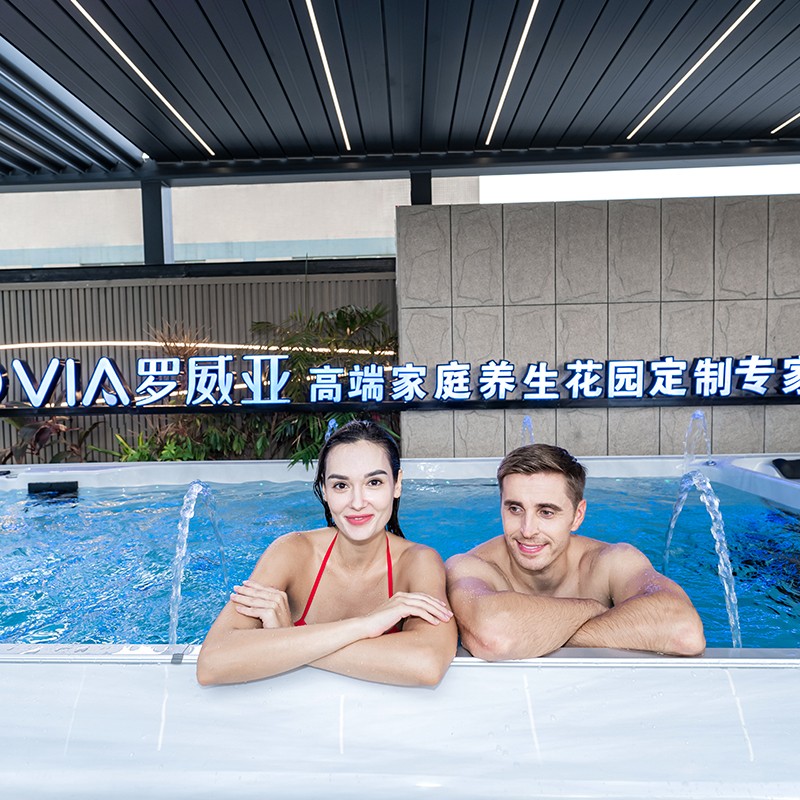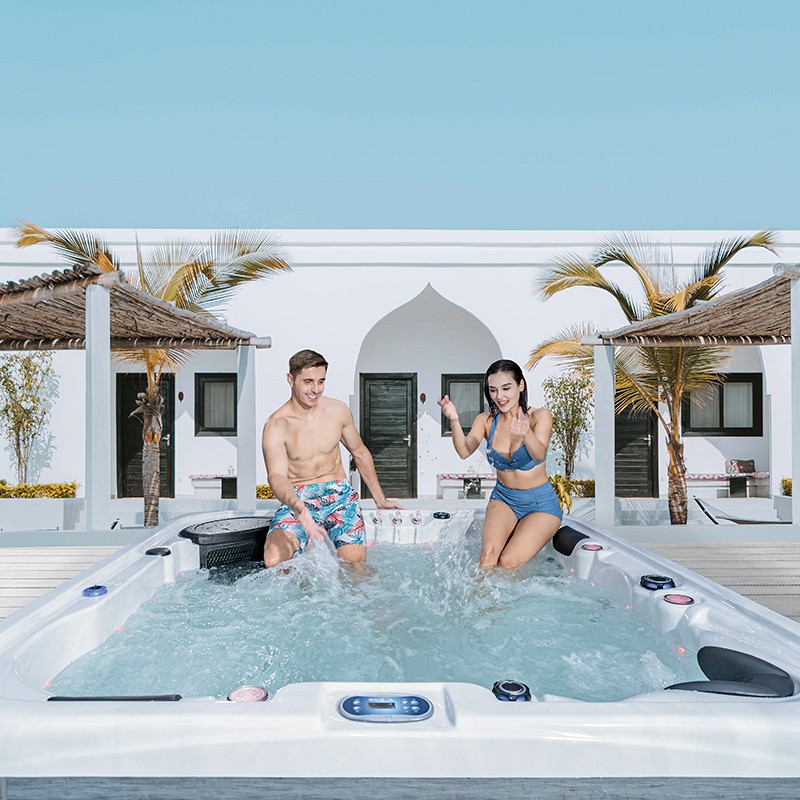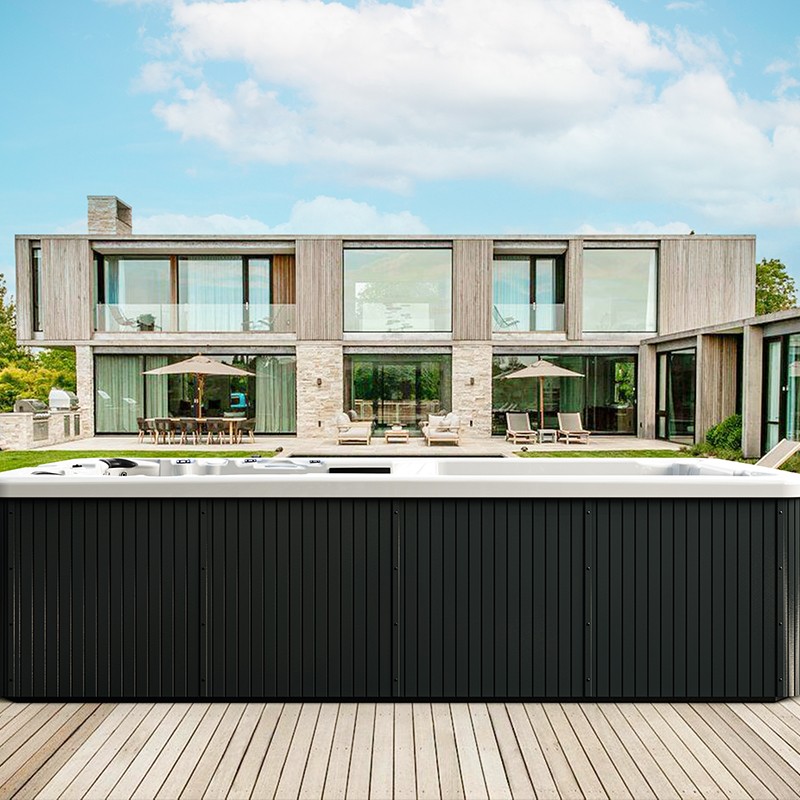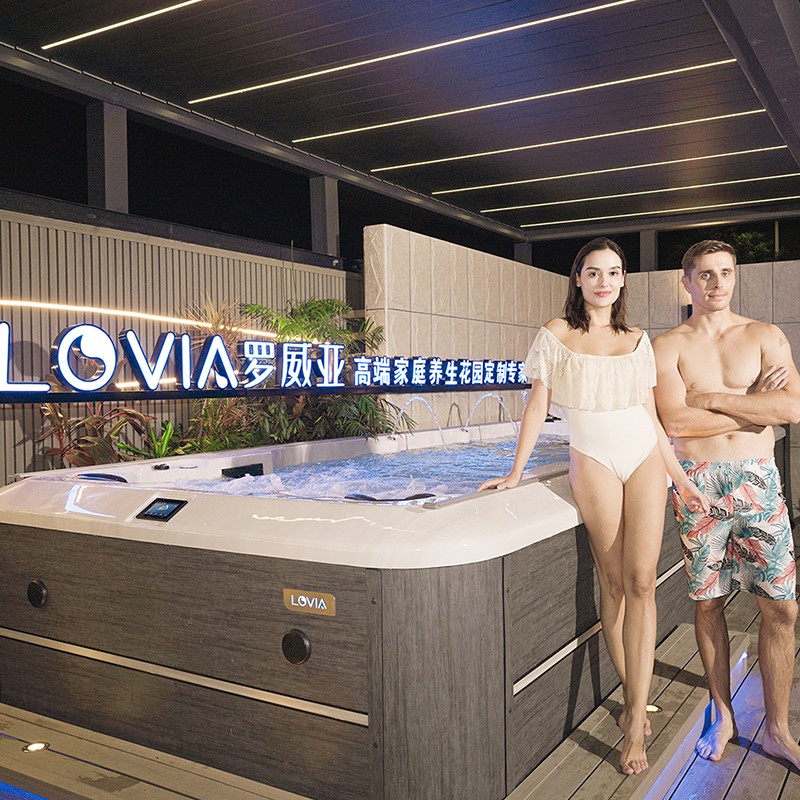
Which two swim spa pool chemicals should never be mixed?
2025-10-25 15:30When maintaining swim spa water quality, the proper use of water treatment chemicals is crucial. Clear, hygienic, and safe swim spa water requires precise chemical control. Commonly used disinfectants, pH adjusters, anti-algae agents, and flocculants play a key role in water quality control.
However, in daily management, many people overlook a serious safety hazard: improper mixing of different chemicals.
Of these, chlorine and hydrochloric acid, two very common chemicals used in swim spa management, should never be mixed or allowed to come into contact. The chemical reaction between the two not only impairs water quality but can also lead to serious safety hazards, such as the release of highly toxic gases, poisoning risks, and even explosions.
This article will delve into why chlorine and hydrochloric acid should not be mixed, explaining the underlying chemical principles, safety risks, and proper operating procedures. This will help swim spa managers and users raise safety awareness and prevent potential accidents.

What are the functions of chlorine and hydrochloric acid in swim spa pools?
1. Function and Use of Chlorine
In swim spa pools, chlorine is the most commonly used disinfectant, primarily killing microorganisms such as bacteria, viruses, and algae.
It can be used in the following forms:
· Liquid chlorine (sodium hypochlorite, NaClO)
· Solid chlorine (such as trichloroisocyanuric acid, TCCA)
· Gaseous chlorine (used in large industrial pools)
Chlorine compounds in water form hypochlorous acid (HOCl). This weak acid has a strong bactericidal effect and is crucial for ensuring the sanitation of swim spa water.
2. Function and Purpose of Hydrochloric Acid
The primary purpose of hydrochloric acid (HCl) in swim spa pools is to adjust the pH of the water. Generally, the ideal pH range for pool water is between 7.2 and 7.8. A pH that is too high can affect the disinfection efficiency of chlorine and cause the water to become cloudy and irritate the skin. A pH that is too low can corrode pipes and damage the pool walls.
To lower a high pH, weak or strong acids are typically used. Hydrochloric acid is widely used due to its low cost and rapid reaction.

The fundamental reason why chlorine and hydrochloric acid cannot be mixed: a violent chemical reaction
Although chlorine and hydrochloric acid both play important roles in swim and spa pool water treatment, they should never be mixed directly, especially in their undiluted, concentrated form, which is extremely dangerous. The main reasons are as follows:
1. Mixing releases toxic chlorine (Cl₂) gas
When chlorine compounds (especially sodium hypochlorite (NaClO)) mix with hydrochloric acid (HCl), the following reaction occurs: NaClO + 2HCl → Cl₂↑ + NaCl + H₂O.
This reaction produces large amounts of chlorine (Cl₂), a yellow-green, irritating gas that is highly toxic and corrosive.
Chlorine gas inhalation can cause harm to the human body, including:
·Severe coughing
·Dyspnea
·Bronchitis or pneumonia
·Severe cases can lead to acute pulmonary edema or death.
Releasing chlorine gas in confined spaces (such as machinery rooms or chemical storage rooms) can cause immediate poisoning and endanger life.
2. Heat release can cause container rupture or explosion
The above reaction is exothermic, and the temperature rise can cause a sharp increase in container pressure. Especially when mixing these two chemicals in a sealed tank, the accumulation of gas and heat can easily lead to:
·Container rupture
·Chemical liquid splashing
·Fire or explosion.
Therefore, this is not just a chemical reaction issue; it's also a serious safety management issue.

The harm of mixing chlorine and hydrochloric acid to swim spa pool equipment and water quality
In addition to posing a serious threat to human health, improper mixing of chlorine and hydrochloric acid can also undermine the stability of the entire swim spa system, affecting water quality and equipment safety.
1. Corrosion of the pool and piping system
The mixed chlorine gas is extremely corrosive. Long-term or single-time, high-volume exposure to chlorine gas can cause:
· Corrosion and perforation of metal pipes
· Short-circuit failure of pumps and electronic control components
· Discoloration and peeling of the ceramic pool wall
· Deterioration and deformation of filters and valve seals
These damages are often irreversible, leading to high repair costs or even requiring complete equipment replacement.
2. Disruption of water quality balance
Chlorine gas escaping disrupts the normal chlorine concentration in the water, rendering disinfection ineffective. Furthermore, unneutralized hydrochloric acid can significantly lower the water's pH, affecting the use of subsequent chemicals and causing problems such as water turbidity and abnormal foaming.
3. Increased operational management difficulties
Once chemicals are accidentally mixed, the swim spa pool water must be immediately replaced or urgently treated, consuming significant resources. Operators will also become even more stressed after the incident, impacting daily management efficiency.
Safety Practices in Swim Spa Pool Management
To avoid the dangers of mixing chlorine and hydrochloric acid, swim spa managers must strictly adhere to the following procedures and safety protocols:
1. Separate Storage
· Hydrochloric acid and chlorine products should be stored in completely separate chemical warehouses;
· Storage rooms should be clearly labeled, ventilated, and leak-proof;
· Storing the two types of chemicals on the same shelves or in the same containers is strictly prohibited.
2. Adding at Different Times
· Chlorine and hydrochloric acid should not be added to the swim spa water at the same time;
· It is generally recommended to add hydrochloric acid first to adjust the pH, then wait at least 30 minutes before adding chlorine products;
· When adding chemicals to the circulation system, ensure that the pump system has fully diluted the previous dose of chemicals.
3. Wear Protective Equipment
Operators handling chlorine or hydrochloric acid must wear the following:
· Acid- and alkali-resistant gloves
· Goggles or face shield
· Long-sleeved anti-corrosion work clothes
· Mechanical ventilation is required in all rooms
4. Develop an Emergency Plan
All operators must receive professional training and be familiar with the following emergency procedures:
· Chlorine gas leak: Evacuate immediately, wear a respirator, and activate the exhaust system.
· Chemical mixture splash: Flush skin with plenty of water and seek medical attention immediately.
· Inhalation poisoning symptoms: Stay away from the area and call for emergency medical attention.
Common Misconceptions and Mishandling Beware
Misconception 1: Pouring chlorine and hydrochloric acid into the same dosing tank
Some operators take shortcuts, believing that the two liquids will be diluted in the pool water and pose no risk. However, at high concentrations or in brief contact, the reaction is rapid, and chlorine gas can be released directly into the dosing tank.
Misconception 2: Neglecting Ventilation
Handling chlorine or hydrochloric acid in an equipment room without a proper ventilation system can easily lead to gas accumulation, potentially poisoning personnel unknowingly.
Misconception 3: Believing that mixing chemicals is sufficient with a "few minutes' interval"
Effective safety intervals are not just a matter of time; they also depend on pool water flow rate, consistent dosing points, and thorough mixing. Thorough mixing and dilution must be ensured before using the second chemical.

Alternative Methods and Optimization Suggestions
If chlorine and hydrochloric acid are used simultaneously in management, the following methods can reduce risk:
· Use an automated dosing system with scheduled dosing times for different chemicals to avoid contact;
· Use a weak acid, such as dry pH adjustment powder, instead of hydrochloric acid to reduce the risk of chemical reactions;
· Use slow-release chlorine tablets to gradually release available chlorine and avoid excessive peak concentrations;
· Conduct regular chemical safety training and simulation drills for operators.
Does LOVIA SPA support bulk purchasing and wholesale orders?
Absolutely. LOVIA SPA is a leading manufacturer and supplier of outdoor spas, swim spas, and hot tubs, offering competitive prices and factory quotes for wholesale and bulk purchases. Buyers can enjoy discounts, promotions, and customized options for large orders. Our products meet international standards with CE, ETL, SAA, ROHS, REACH, and ISO9001 certifications.
Bulk purchasing from LOVIA SPA allows clients to access top-quality spas at low prices while benefiting from a trusted supplier with decades of manufacturing experience.
